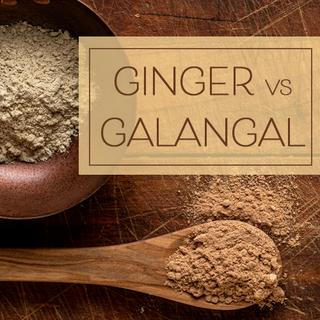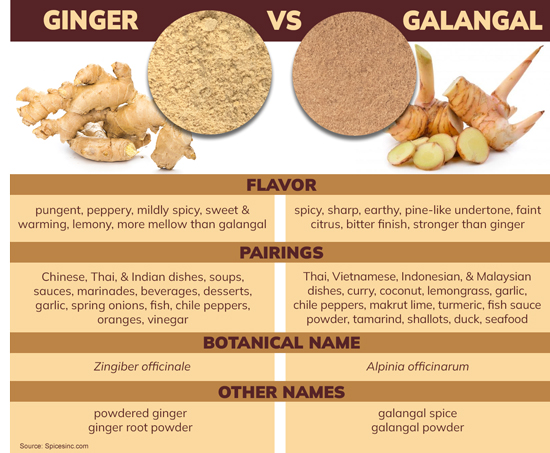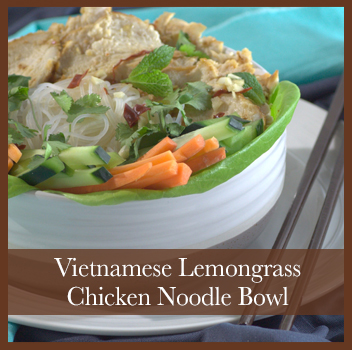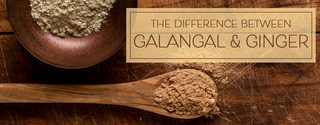The Difference Between Galangal and Ginger

The Difference Between Galangal and Ginger
Despite their similar appearances, ginger and galangal are two different spices, differentiated by the way they taste. Galangal is peppery and earthy with hints of mustard. It’s got citrusy top notes and a bitter finish. Ginger is spicy but sweet, with a strong lemon aroma and a mellow finish that gently fades.
Ginger and galangal are cousins. They are both members of the Zingiberaceae family, which includes other pungent, aromatic spices like cardamom and turmeric. The resemblance ginger and galangal bear to each other is striking, particularly if they’re seen when they are fresh. They are both rhizomes—stems of a plant that grow horizontally below the ground. They send out both roots that burrow deep into the earth and shoots of new plants that reach upward, which explains why the fresh roots are so knobby.
Fresh ginger has warm yellow flesh and a rough brown, almost papery, exterior. The peel is very easy to remove and can even be pulled away with the end of a teaspoon. The flesh is fibrous but easy to slice or mash, and it contains so much moisture that it’s almost juicy when cut.
Galangal root has a light tan exterior with darker brown rings. This exterior is harder than ginger peel and has to be removed with a vegetable peeler or sharp knife. The flesh of a galangal root can be dusky white or pale yellow and is very firm. It has more fiber than ginger root and is much denser. Because of the fibrousness, fresh galangal should be shredded or sliced very thinly. Larger pieces can be tough to chew.
Table of Contents
What is Galangal Powder

Galangal Powder is the result of drying and pulverizing a fresh galangal root. Our dried galangal comes from what is known as “lesser galangal”, Alpinia officinarum, which is native to China. Lesser galangal, despite its name, is more peppery and bold than greater galangal. It is commonly called dried galangal, galangal spice, or just galangal, and it is primarily used in the cuisines of Asia, Southeast Asia, and the South Pacific.
Because Galangal Powder comes from a dense root, the powder is heavy and has a bit of textural toughness. When galangal is dried, the citrusy aspect of the fresh root becomes less pronounced, and its peppery qualities come to the forefront. Galangal Powder is spicy, evoking a combination of mustard and black pepper that fades into a bitter finish. There are faint top notes of citrus and pine. The earthy depth of Galangal Powder can be balanced easily by the addition of some Ground Cardamom, which will provide notes of lemon and orange and a touch of mint. It is often combined with Lemongrass Powder. You could also include some fresh orange or lime zest for balance.
Galangal is more closely associated with Southeast Asian cuisine than food from China or India. Choose it if you’re making Thai, Vietnamese, Indonesian, or Malaysian foods. It adds earthy depth to the floral nuttiness of coconut and complements lemongrass, as seen in a Vietnamese Lemongrass Chicken Noodle Bowl. Its primary purpose in a recipe is to round out food flavors and provide depth. Aside from coconut and lemongrass, pair galangal with garlic, chile peppers, makrut lime, turmeric, fish sauce powder, tamarind, shallots, duck, and seafood, and in various curry pastes.
What is Ground Ginger
Ground ginger, or Ginger Powder, is the pulverized powder that comes from dried Zingiber officinale, or ginger root. It is also known as powdered ginger or ginger root powder.
The yellow flesh of fresh ginger turns pale as it dries and produces a light, white-to-tan powder that’s delicate and fluffy. Ginger Powder delivers a peppery bite and has a decided sweetness that overarches the pepper, with an abundantly lemony top note. The combination of sweetness and pepper helps give complexity to baked goods and treats. Ginger’s heat sparks are felt immediately but fade just as quickly, leaving behind more of a sense of freshness and invigoration than anything else.
Ginger is often considered a staple spice in Thai cuisine, even though galangal is the more traditional spice to use in Thai cooking. Recipes like Thai Chicken Wrap benefit from ginger’s less complex flavor profile, though you can undoubtedly add galangal if that’s your preference.
Ginger Powder is traditionally used in Chinese cooking. It’s a standard ingredient in Chinese stir-fry meals like the Sichuan Pepper and Beef Stir Fry. It’s a vital ingredient for sauces, as it gives aromatic richness to the sweet soy sauce glaze in Sesame Chicken. It is also a standard ingredient in almost all Indian dishes; try it in Vegetable Jalfrezi or mixed into the seasoning base for a classic Indian Fish Curry. You can also pair ginger with garlic, spring onions, fish, chile peppers, oranges, and vinegar, as a pickled condiment, in soups, marinades, beverages, and desserts.
Can I Substitute Galangal and Ginger

Galangal and ginger are often substituted for one another, but these spices have different flavor characteristics and are
not suitable substitutes.
Galangal is hotter and more astringent than ginger, with a solidly bitter finish. Its flavor is significantly more intense than that of ginger. Adding galangal to a dish that calls for ginger will fundamentally change the overall taste of a dish and will take it in a more bitter, earthy, bold direction. This may be acceptable if you’re making a stir fry, but it will not do in more delicate dishes like Asian Chicken Lettuce Rolls or sweet recipes like desserts or sodas.
Conversely, ginger is mellower and sweeter than galangal. It is a more straightforward swap because ginger’s gentler flavor won’t behave aggressively in a recipe. Since ginger is more readily available in the US, it is commonly seen as an easy substitute, but it doesn’t have the same grounded boldness that galangal delivers. If you decide to substitute ginger for galangal, try adding something earthy, like turmeric, and bulk up a little on the black pepper or black mustard seed to give it a bit more bite.
Best Spices to Substitute Ground Ginger
Ginger can be used in sweet and savory applications; if you need a substitute for ginger, you should consider the nature of your dish.
For sweet foods, like cakes or cookies, cinnamon makes a good swap for ginger. It is woodsy and sweet with a touch of peppery heat. You can also use allspice, nutmeg, or cardamom.
If you’re making a savory dish, try swapping in its cousin, turmeric, with a touch of clove. Cardamom and mace are great savory substitutes for ginger, with its heat replicated by a bit of black or white pepper or even a mild chile powder.
Ginger and galangal may bear a striking resemblance to one another, but these are two very different spices with unique flavor profiles. They’re both terrific when used for the cuisines, and the individual dishes accentuate their better qualities, but they can get lost in the mix or be aggressive when misused. Learn the differences between these two spices to recreate your favorite Thai, Vietnamese, Chinese, or Indian-inspired dishes at home with culinary confidence.

